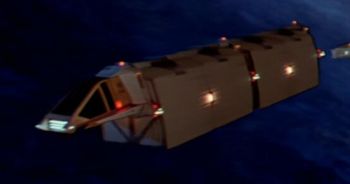Work Bee
The Work Bee was a small, microfusion-powered utility craft that was in continuous service with Starfleet since 2268,[1] and it quickly became a workhorse of the Federation. The Work Bee was designed as part of a modular construction/support system, and could be attached to a variety of specialized work-sleds and towing attachments.[2]
The Work Bee carried a single crew member,[2] who usually wore at least an emergency pressure suit to protect against accidental depressurization.[1] The Work Bee, however, was often used unpressurized, and the crew member wore a full Environmental suit,[2] allowing the operator to exit the craft, perform any work not possible with the manipulator attachment waldoes, and return to the control seat.[1] When used in this manner, life support for the suit could be provided by tanks in the craft, via a retractable umbilical that could extend beyond the Work Bee for extravehicular activity (EVA). Connectors within the cockpit could also be used to supply power for cutting and welding equipment, as well as most other powered tools used by construction personnel.[2] Although gravitational acceleration into the pilot chair could be ramped,[1] most operators preferred a null-g environment,[2][1] in order to minimize disorientation[1] and quickly facilitate EVAs during construction projects.[2] The onboard life-support system could provide full life support, including atmosphere, drinkable water, and temperature control for the pilot for twelve[2] to fifteen hours.[1]
Attachments for the unit included a grabber sled, which utilized clawed mechanical waldoes for deep space damage repair and standard external starship maintenance, as well as a specialized cargo train, which could carry up to eight cargo pods at a time.[2] The frame of the cargo train was equipped with additional RCS thrusters, which were commanded by the Work Bee's flight controls.[1] Work Bees could soft-dock at specialized ports within a properly-equipped landing bay; these ports featured pressurized walkways that led directly to the open cab cockpit, which allowed crew members to enter the craft without an environmental suit, even when the landing bay was depressurized.[2] Fuel cell and microfusion EPS power was rated at 76.4 hours, allowing multiple operational runs before recharging was necessary.[1]
